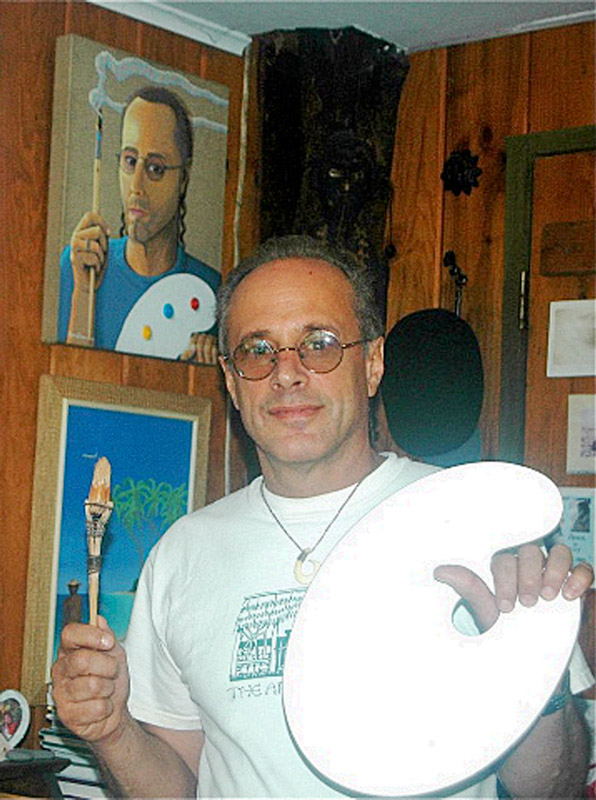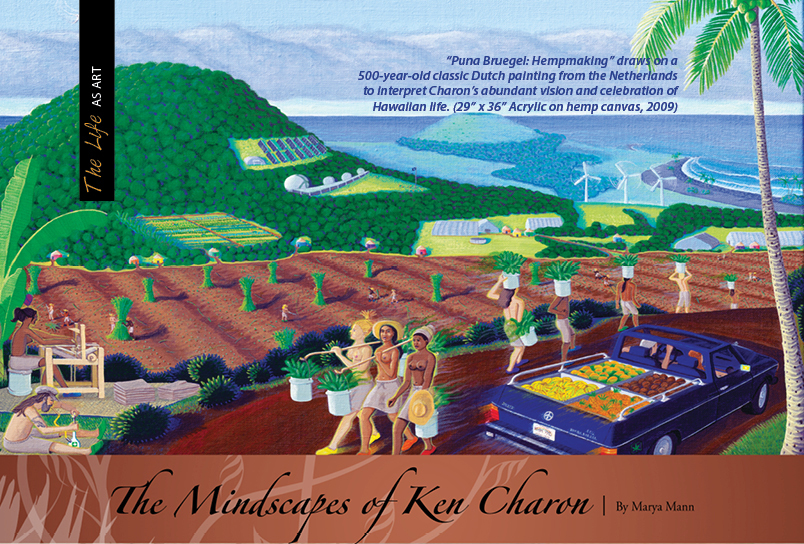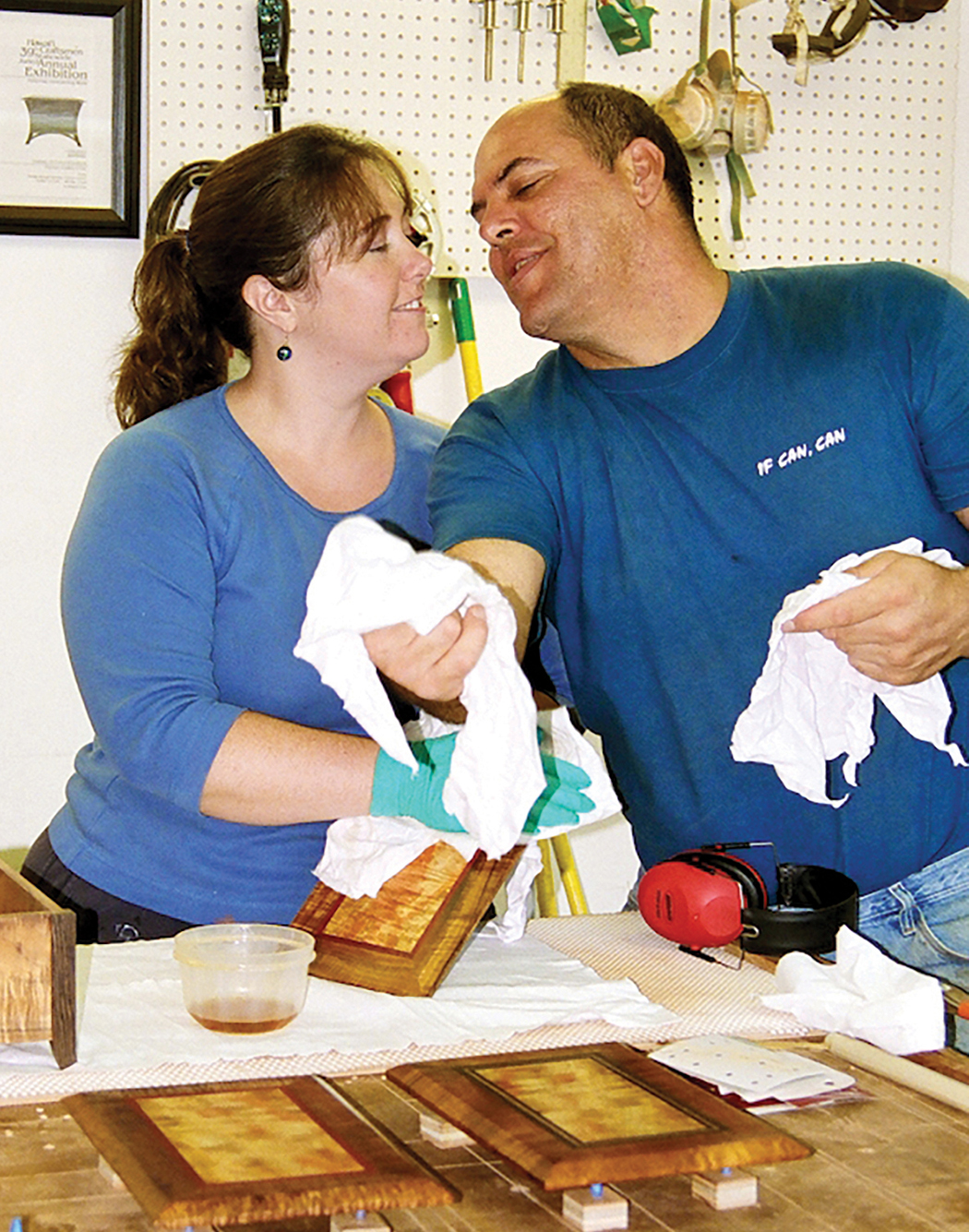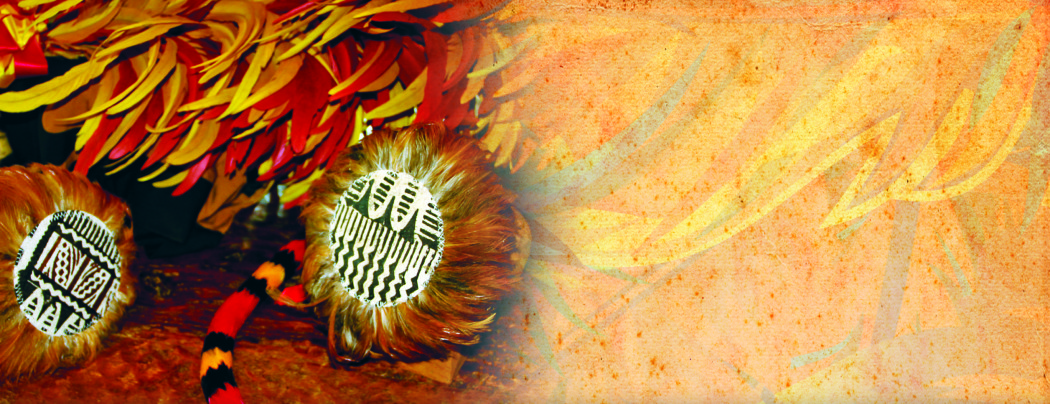
The Mindscapes of Ken Charon

By Marya Mann
If we could climb inside Ken Charon’s dreamy paintings for a fantastic journey, we might feel the summer breeze on our faces as we trek up an emerald green volcano and wake up in a manger where Hawaiian prophets are being born.
From the Big Island slope we could hike down to a soft desert plain, nuzzle up to Muhammad who is hugging Christ, then hop into a double-hulled canoe and voyage on the ancient ocean of outer space, as acrobatic planets and luminous stars glitter and glow.
Wearied by our astronautical feat, we might dive into the sea with dolphin and whale, then rest in the kindly caress of Queen Liliuokalani as she cradles Hawai‘i’s island gems, like chakra points lined up along the rising and falling breath of the royal chest.
Best of all, our magical journey through the idealistic, surreal and space art treasures of Ken Charon could alter the mindscape as well as the landscape with his fresh, genuinely visionary approach to human destiny.
“I feel that it’s the artist’s role and almost duty to move civilization along,” says the artist, “so I use my art to try to promote things that I believe in, including nonviolence, ecological wisdom, world peace and interracial harmony.”
The painter, scholar, pioneer, dream weaver, political activist and leader of art hikes to the top of Mauna Loa wanted to make a painting to help stop the war in the Middle East. “It was 2004 and we were invading Iraq. I decided to paint Jesus and Muhammad, posing and smiling together like people always do.” Except they’re standing on a peace symbol inside rings of color as soldiers drop their rifles in the distance, all showered by a nervy, celestial light. “I made cards of this one,” he says, handing me a 3 x 5 greeting card of “Jesus Meets Muhammad,” which he hopes will convince warring tribes to behave like the family they are.
“I went to Europe and brought a hundred of them with me. I would hand them to people in the streets, to people I didn’t know, and to young Arab men when I’d see them. So I was able to make peace one person at a time. I gave all of them away and only two people objected.” For his noble, mobile art mission, he received dozens of hugs and handshakes.
Today, he creates art at his home in the Hawaiian rainforest of Puna District, the Charon Art Farm, a three-acre parcel on the slopes of Kilauea Volcano which has become his “artist’s statement.” Powered by solar energy, surrounded by an organic fruit orchard, gardens and native forest, the home and studio reflect his devotion to helping “more people in the mainstream come to terms with a much needed environmental revolution.”
Chicken Skin Moments Might Do It
Inside the house, we are surrounded by paintings, ambient colors and forms, testimony to Charon’s lifelong commitment to a greener golden age, blessed by Hawaiian Aphrodites and peace-loving beings. Shamanic prayer paintings of his children, Roy and Nicole, hang in the studio and award-winning “Trash Art” made with bottle-tops soars on the ceiling in the bathroom.
His wife, artist Rebecca Rosen Charon, has painted some of the art work lining the walls, and she often poses as an inspired goddess or mythical creature in her husband’s work. Various renditions of her Venus-like proportions rise up in paintings and sculpture that trickle out to the lanai, upstairs into the studios, and into another bedroom. After Rebecca makes tea, we sit at the kitchen table and ponder the daring dimensionality of Ken’s work—one brush stroke, one conversation, and one chicken skin moment at a time.
“I have a range of surfaces from super smooth to coarse burlap,” Ken says. “Now I paint everything on hemp, but this mermaid was painted on masonite,” he says, pointing to the three-foot undersea view of Rebecca scuba diving and posing as a mermaid, which hangs in the kitchen. “But that was my smooth stage,” he says.
“He has trouble actually doing straightforward subject matter,” says Rebecca. “There are always surprises in them for those who look closer.” She walks to the mermaid on the wall. “I had just gotten to the island and moved here, and Ken thought, ‘Oh, mermaids.’ So he painted (me as a mermaid), but the next thing you know, he turned it into this. So it’s more than just a mermaid. His son’s meditating underneath her.”
Art at the Charon farm is a family affair, also an international affair. Seeds for the Charons’ extraordinary vision of a balanced, harmonious, aloha-filled future first sprouted in Paris, France, where Ken lived between the ages of 17 and 30, honing his craft at the American Center for Students and Artists and the Academy Julian. His countless visits to European art museums for close-up investigations of the Old Masters fostered an impressive virtuosity that gave wings to his talent. In 1978, he traveled from Paris to the tropical Seychelles, a trip that changed his life.
Living with a local island family for seven months on the isolated archipelago in the Indian Ocean fired his aesthetic sensibilities. He produced 25 paintings and hundreds of photos exhibited later in Paris, and he hasn’t stopped painting since. His groundbreaking religious, surreal and social art pieces have won Biennale medals and international awards along the way, but his vision expanded when he moved to the Healing Island in 1984.
Integrating Hawaiian values of malama `aina (caring for the land), lokahi (unity, harmony) and laulima (working together, family), he joined Green Party colleagues in 1990 to protest the geothermal plant in Puna. Some activists chained themselves to the gates and they all wound up in Time magazine as saviors of the Hawaiian rainforest.
That wasn’t the last time that Charon stuck his neck out for a cause.
Messages for the Community
Not far from Charon’s Art Farm, in a typical Charon art exchange, Ken graced the Malia Puka O Kalani Church in Hilo with two murals in exchange for the preschooling of his two children. His sacred paintings in the Catholic sanctuary suggest we can be renewed by reconnecting more deeply with nature.
“Ho Mai Ke Ola Hou” or “Source of Life Renew Us” (acrylic on canvas, 1987) illuminates one end of Malia Church near Puhi Bay. At the center of the 209” x 146” canvas, the flaming light of Kilauea Volcano dances in the heart of a balanced triangle of life. The vivid earth below, spacious atmosphere in the middle, and awe-filled heavens above, recalls the many dimensions in which we live—biological and mythic.
Showing me a reproduction, he says, “Painting takes me into a zone like meditation, and this is what I see. I have the plants here, two-by-two, as if it’s a Noah’s Ark type of thing. There’s two banana trees, two mango trees, two mountain apple trees, two breadfruit trees.”
Upstairs at the Art Farm, he points to “Dream Triptych,” his overview of past, present and future. “I feel like it’s my duty to paint for the community, not just for the people that are going to buy the painting, but to create messages that will inspire people.”
With the early afternoon light behind me, so fine are the brushstrokes in “Dream Triptych,” I want to touch the surface of the panels to be sure it’s acrylic on canvas, and not a window looking out on a supernatural, new world.
The left panel depicts Hawaii’s indigenous past, the natural kinship engendered by awa ceremony, harmony with nature and agricultural abundance. Today, now, the choice-point, faces us in the central panel. A triangle of life energizes the cellular phone-toting, multi-cultural friends in a free-spirited gathering. Serious and sensuous, one woman smokes marijuana, which expands and grows into a cocoon of new orbed life in the right panel, a future utopia of energetic alignment, a fusion of the best of our ancestral past with a new alignment of botanical, social and technical innovation. A solar-paneled, organic future, in other words, like Charon’s Art Farm.
“Puna Bruegel: Hempmaking”
Flemish painter Pieter Bruegel’s “Haymaking” brought to life a vivid scene of the rituals of life in a 16th century farming village, a vanished culture of home, hunts, meals, festivals, dances and games. Using abundant spirit and comic power, Charon drew on the master’s celebration of life in the Netherlands 500 years ago to create “Hempmaking.”
“I Punafied it,” he says, which transformed the Flemish painter’s original trio of happy farm women hauling the day’s yield into fit, multi-racial, bare-breasted beauties. Emerald green bunches of freshly harvested hemp are ready to be transformed under a lavender and aquamarine sky into their many valuable cultural uses—food, fuel, paper, medicine and textile fibers woven by a weaver at her loom in the foreground. Did you know, the word “canvas” is derived from the Anglo-French word, cannabis, “made of hemp?”
Painting for a Cause
Charon might look like a 50-something Harry Potter and paint a little like Salvador Dali, the master of melting timepieces—and one of Charon’s first heroes—but unlike Dali who loved to talk about his own genius, Charon’s favorite subjects are peace and love—Dali without the duality.
So when a friend got into trouble, Charon stuck his neck out again. When Roger Christie, long-time advocate of the religious use of cannabis on the Big Island of Hawai‘i, was arrested by federal authorities, it disturbed Charon’s peace of mind. “He has to wait seven months for his trial so he’s in a federal lockdown over there in O‘ahu and the judge wouldn’t grant him bail because they said he was a danger to the community, and Roger has never hurt anybody.”
Thinking the unjust imprisonment of the minister practicing his religion was intolerable, Charon brought together other artists, Sara Steiner-Jackson (“Medical Marijuana”), Barry Wilkinson (“This Bud Is for You”) and Tomas Belsky (“Just Say Know”) who donated their images to sell at the Free Roger website to benefit Christie’s legal defense team. In exchange for these high-quality (excuse the pun) cannabis-theme art prints, suitable for framing, supporters can support Christie’s legal defense.
By bringing his naturalist’s eye to the world of politics, his art exists in a kind of unified field that may reflect the most revolutionary part of Ken’s work. He mastered the European painting traditions and then aimed their full power at transforming many of its dominator values, using old styles and designs to animate his radical, earthy solutions for today’s problems.
Charon bathes us in earthly delights. He changes our perspective through organic forms. With his clear-headed mapping of visionary dreams, he charts refreshing new possibilities for culture, inviting us to look at non-ordinary ways to successfully navigate the ever-changing terrain. On this journey, Charon is framing more than paintings; he’s re-framing the conversation.
O-o-oh, chicken skin!
Ken Charon prints and paintings can be purchased by appointment at the Art Farm in Kurtistown, 808.966.7343, and at these Hawai‘i Island locations:
- Jungle Love at the Malama Marketplace in Pahoa: 808.965.7775
- Volcano Art Center in Hawai‘i Volcanoes National Park: 808.967.7565
Ken and Rebecca join ART DAY GROUP, a group of artists who converge on the pavillion at Ahalanui /Warm Ponds Park every Friday at 10am for a public art session. It’s near Kapoho on the Red Rd, between Pohoiki & Kapoho. Art lovers of all ages are welcome.
Photos courtesy of Ken and Rebecca Charon


